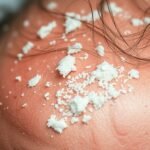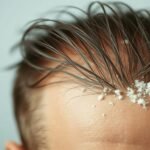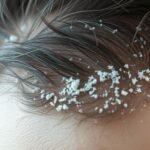Have you ever wondered if candida causes dandruff? Research shows a link between candida and dandruff. If you have eczema or dandruff, learning about this connection might interest you.
Understanding candida and dandruff can improve your scalp health. Many treatments for skin conditions are unnecessary. It’s important to find the real cause of your symptoms.
Key Takeaways
- Candida albicans is a common type of yeast that can cause skin infections, including scalp yeast infections.
- Fungal overgrowth and dandruff may be connected, with some research suggesting that candida can contribute to dandruff.
- Factors such as antibiotic usage, high-sugar diets, and stress can contribute to candida overgrowth and increase the risk of scalp yeast infections.
- Antifungal treatments, such as azoles, have a high success rate in treating candidiasis on the scalp.
- Understanding the connection between candida and dandruff can help you take control of your scalp health and address the underlying causes of your symptoms.
- Dandruff affects 50% of the global population, and pruritus (itchiness of the scalp) occurs in 66% of dandruff cases.
- Candida albicans is responsible for 65.3% of candidiasis cases, making it a significant contributor to scalp yeast infections.
Understanding the Candida-Dandruff Connection
Exploring the link between candida and dandruff is key. Candida is a fungus that can lead to scalp yeast infections. Malassezia yeast also plays a role in dandruff. Studies show Candida is a common cause of skin and organ infections.
About 50% of people over puberty have dandruff. Research finds more Malassezia fungus on dandruff scalps than healthy ones. The scalp’s many sebaceous glands increase Malassezia, breaking down oils and causing irritation.
What is Candida?
Candida is a fungus found on the skin and in the body. It’s usually harmless but can cause infections if it grows too much. Candida and dandruff often go hand in hand.
How Candida Affects Your Scalp
Candida can cause yeast infections and scalp issues. It breaks down scalp oils, leading to irritation and inflammation. This can cause dandruff symptoms like flaking, redness, and itchiness.
The Role of Malassezia Yeast
Malassezia yeast also contributes to dandruff. It’s found on the scalp and breaks down oils, causing irritation. The mix of candida and Malassezia can worsen scalp problems, making treatment and prevention important.
Does Candida Cause Dandruff? The Scientific Evidence
Studies show that Candida can cause scalp yeast infections, which might lead to dandruff. The connection between candida and dandruff is being explored. Some research suggests that fungal overgrowth and dandruff are linked. It seems that dandruff from candida overgrowth is a big issue for many.
Some interesting facts about dandruff include:
- Dandruff affects almost 50% of people before they hit puberty, no matter their gender or ethnicity.
- The amount of Malassezia spp. doubles during dandruff and seborrhoeic dermatitis.
- The process of scale detachment is linked to the severity of symptoms.
There’s a strong link between seborrhoeic dermatitis and dandruff. Even mild forms of seborrhoeic dermatitis can look like dandruff. While we’re not yet sure how Candida and dandruff are connected, it’s clear they’re related. More research is needed to understand this link and find better treatments for dandruff from candida overgrowth.
| Condition | Normal Level | Dandruff Level |
|---|---|---|
| Malassezia spp. | 10^3 to 10^5 organisms per mm² | 1.5 to 2 times normal level |
| Parakeratotic cells | Present | Increased |
Identifying Candida-Related Dandruff Symptoms

Understanding the link between candida and scalp health is key. Yeast infections can make scalp issues hard to spot. But knowing the signs is the first step to treating them.
Look out for an itchy, flaky rash on your scalp. This could mean you have too much candida.
If you see severe itching or redness on your scalp, see a doctor. They can figure out what’s wrong and suggest how to fix it. The Mayo Clinic says you can use antifungal shampoos or foams to treat scalp yeast infections.
Here are some common signs of too much candida:
- Itchy, flaky rash on the scalp
- Redness and inflammation
- White or yellowish scales on the scalp
It’s important to tell regular dandruff from candida-related dandruff. Knowing about scalp health and candida helps you start treating dandruff and scalp issues.
Treatment Options for Candida-Related Scalp Issues

Understanding the link between scalp health and candida is key. Yeast infections and scalp problems can be tough to tackle. But, there are many ways to treat them. Over-the-counter (OTC) treatments like antifungal shampoos or foams work well.
Some common treatment options include:
- Antifungal shampoos or foams
- Prescription medications, such as oral antifungals
- Natural remedies, such as tea tree oil or coconut oil
Dealing with candida-related scalp issues needs a full plan. This includes keeping your scalp healthy and tackling any underlying issues. Knowing about the scalp and candida connection helps you start treating and preventing problems.
Good hygiene and a clean scalp are also vital. They help stop yeast from growing too much. By using these methods together, you can manage scalp issues and keep your scalp healthy.
| Treatment Option | Effectiveness | Duration of Treatment |
|---|---|---|
| Antifungal shampoos | High | 2-4 weeks |
| Prescription medications | High | 2-6 months |
| Natural remedies | Varying | Ongoing |
Natural and Medical Solutions for Managing Yeast Overgrowth
Understanding the link between candida and dandruff is key. You can manage fungal overgrowth and dandruff with natural and medical methods. Keeping your scalp healthy is a good start.
Antifungal treatments, like those with zinc pyrithione or selenium sulfide, fight fungal infections. Cutting down on sugar can also stop yeast overgrowth. Plus, good hygiene and stress management help keep your scalp in check.
Here are some important tips for managing yeast overgrowth and dandruff:
- Use antifungal shampoos or treatments to control fungal growth
- Eat a balanced diet to prevent yeast overgrowth
- Practice good hygiene and manage stress for a healthy scalp
By understanding the link between candida and dandruff, you can lower your risk of dandruff. Taking steps to manage yeast overgrowth is key. Remember, does candida cause dandruff? Yes, it does, but with the right approach, you can prevent it.
| Treatment | Effectiveness |
|---|---|
| Antifungal shampoos | Highly effective in treating fungal infections |
| Dietary modifications | Helpful in preventing yeast overgrowth |
| Lifestyle changes | Contribute to a healthy scalp and reduce stress |
Conclusion: Taking Control of Your Scalp Health
The link between Candida yeast and dandruff is complex and often misunderstood. But, by understanding the causes of candida yeast and dandruff, you can manage yeast infections and scalp issues. This helps keep your scalp healthy and balanced.
Using a holistic approach is key. This includes making dietary changes, adjusting your lifestyle, and using antifungal treatments. Your scalp health shows your overall wellbeing. So, take care of yourself and seek help when you need it.








Honestly, guys, I think were overthinking this. Perhaps dandruff is just about poor hygiene rather than a Candida infestation. Thoughts?
Poor hygiene, really? Maybe its time for some basic biology lessons, mate.
Interesting read, but isnt dandruff more about dry scalp than candida? Maybe were overcomplicating things? Just a random thought.
Interesting read, but isnt it possible that dandruff is more related to dry scalp rather than Candida? Just throwing it out there!
Interesting take, but isnt it more plausible that dandruff is caused by dry scalp rather than Candida? Just thinking out loud here.
Interesting article but isnt it more likely that poor hygiene causes dandruff, not Candida? Anyone else think this is a bit of a stretch?
Poor hygiene can contribute, but research shows Candida is a common culprit too. Dont oversimplify!
Interesting read, but isnt it oversimplifying to just blame Candida for dandruff? What about stress, diet, or improper hair care? Thoughts?
Interesting read, but isnt it more about poor hygiene than Candida causing dandruff? What about other factors like diet and stress? Just asking.
Interesting article, but isnt it possible that dandruff is more about dry scalp than Candida? Maybe were overcomplicating things? Just a thought.
Interesting article, but isnt it too simplistic to blame dandruff solely on Candida? What about diet, stress, and other factors we deal with daily?
Agreed, its naive to pin dandruff solely on Candida. Lifes more complex than single-cause issues.